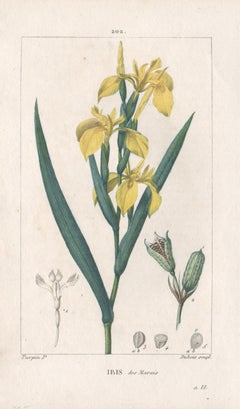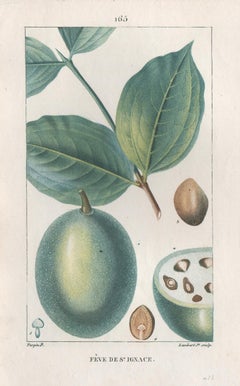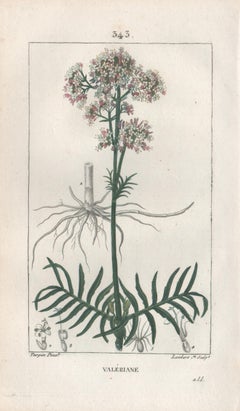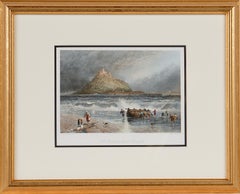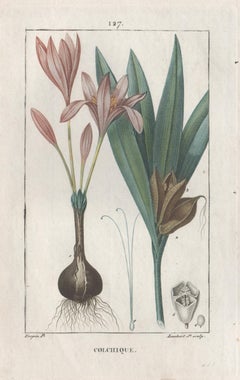After Pierre Turpin Art
to
5
5
Iris des Marais (Yellow Iris), French botanical herbal flower engraving, 1818
By After Pierre Turpin
Located in Melbourne, Victoria
French botanical flower engraving, 1818.
Colour-printed stipple engraving by J Lambert after Pierre Turpin (1775-1840)
From Francois Pierre Chaumeton's 'Flore Medicale' which portrayed a variety of flowers, trees and herbs which could be used for treating illnesses. The engravings were produced during the great period of French colour printing using the stipple-engraving process pioneered by the great botanical artist Pierre-Jospeh Redoute. The artist is the celebrated Pierre Jean Francois Turpin...
Category
Early 19th Century Victorian After Pierre Turpin Art
Materials
Engraving
Feve de St Ignace (Strychnos ignatii), French botanical flower engraving, 1818
By After Pierre Turpin
Located in Melbourne, Victoria
French botanical flower engraving, 1818.
Colour-printed stipple engraving by J Lambert after Pierre Turpin (1775-1840)
From Francois Pierre Chaumeton's 'Flore Medicale' which portrayed a variety of flowers, trees and herbs which could be used for treating illnesses. The engravings were produced during the great period of French colour printing using the stipple-engraving process pioneered by the great botanical artist Pierre-Jospeh Redoute. The artist is the celebrated Pierre Jean Francois Turpin...
Category
Early 19th Century Victorian After Pierre Turpin Art
Materials
Engraving
Tamarin (Tamarind), French botanical herbal medicinal flower engraving, 1818
By After Pierre Turpin
Located in Melbourne, Victoria
French botanical flower engraving, 1818.
Colour-printed stipple engraving by J Lambert after Pierre Turpin (1775-1840)
From Francois Pierre Chaumeton's 'Flore Medicale' which portrayed a variety of flowers, trees and herbs which could be used for treating illnesses. The engravings were produced during the great period of French colour printing using the stipple-engraving process pioneered by the great botanical artist Pierre-Jospeh Redoute. The artist is the celebrated Pierre Jean Francois Turpin...
Category
Early 19th Century Victorian After Pierre Turpin Art
Materials
Engraving
Valeriane (Valerian), French botanical medicinal herbal flower engraving, 1818
By After Pierre Turpin
Located in Melbourne, Victoria
French botanical flower engraving, 1818.
Colour-printed stipple engraving by J Lambert after Pierre Turpin (1775-1840)
From Francois Pierre Chaumeton's 'Flore Medicale' which portrayed a variety of flowers, trees and herbs which could be used for treating illnesses. The engravings were produced during the great period of French colour printing using the stipple-engraving process pioneered by the great botanical artist Pierre-Jospeh Redoute. The artist is the celebrated Pierre Jean Francois Turpin...
Category
Early 19th Century Victorian After Pierre Turpin Art
Materials
Engraving
Renoncule des marais (Buttercup), French botanical flower engraving, 1818
By After Pierre Turpin
Located in Melbourne, Victoria
French botanical flower engraving, 1818.
Colour-printed stipple engraving by J Lambert after Pierre Turpin (1775-1840)
From Francois Pierre Chaumeton's 'Flore Medicale' which portrayed a variety of flowers, trees and herbs which could be used for treating illnesses. The engravings were produced during the great period of French colour printing using the stipple-engraving process pioneered by the great botanical artist Pierre-Jospeh Redoute. The artist is the celebrated Pierre Jean Francois Turpin...
Category
Early 19th Century Victorian After Pierre Turpin Art
Materials
Engraving
Related Items
The German Chapel in St. James Palace, A 19th Century Hand Colored Engraving
By Charles Wild
Located in Alamo, CA
A hand-colored engraving of the interior The German Chapel, St. James Palace in London, England from 'The History of the Royal Residences of Windsor Castle, St. James Palace, Carlton House, Kensington Palace, Hampton Court, Buckingham House, and Frogmore', commissioned by the British Royal Family. The work is one of the finest depictions of interiors ever published. The engraving was created by Daniel Havel (1786-1826) after a painting by Charles Wild (1781-1835) and published by William Henry Pyne (1770–1843) in 1819.
The print is presented in a gold-colored wood museum style frame and an elaborate light grey French mat with highlighted gold and royal blue bands. A certificate of authenticity from Trowbridge Gallery...
Category
Early 19th Century Victorian After Pierre Turpin Art
Materials
Aquatint
H 23.25 in W 20.88 in D 1 in
St. Michael's Mount, Cornwall: A Framed 19th C. Engraving After Myles Foster
By Myles Birket Foster
Located in Alamo, CA
This beautiful 19th century framed hand-colored engraving is entitled "St. Michael's Mount, Cornwall" by J. Saddler after an original painting by the British artist Myles Birket Fost...
Category
Mid-19th Century Romantic After Pierre Turpin Art
Materials
Engraving
H 14.38 in W 17.88 in D 1.5 in
Ireland: A Framed 17th Century Hand-colored Map by Jan Jannson
By Johannes Janssonius
Located in Alamo, CA
This is a 17th century hand-colored map entitled "Hibernia Regnum Vulgo Ireland" by Johannes Janssonius's (Jan Jansson), published in Amsterdam in 1640. This highly detailed map depicts the Emerald Isle with an extensive display of towns, roads, mountains, rivers, lakes and county borders, etc. It includes two decorative cartouches on the left. The title cartouche includes the Irish harp and the second, in the upper left, includes a lion wearing a crown on the left, a unicorn on the right and a coat-of-arms in the middle, which includes another Irish harp. A distance scale is seen in the lower right, augmented with two putti. The map is embellished with three sailing ships and a sea monster. Western portions of Scotland and England...
Category
Mid-17th Century Old Masters After Pierre Turpin Art
Materials
Engraving
H 17.88 in W 22 in D 0.75 in
View of Emden, Germany: A 16th Century Hand-colored Map by Braun & Hogenberg
By Franz Hogenberg
Located in Alamo, CA
This is a 16th century original hand-colored copperplate engraved map of a bird's-eye View of Embden, Germany entitled " Emuda, vulgo Embden vrbs Frisia orientalis primaria" by Georg Braun & Franz Hogenberg, in volume II of their famous city atlas "Civitates Orbis Terrarum", published in Cologne, Germany in 1575.
This is a beautifully colored and detailed map of Emden, a seaport in northwestern Germany, along the Ems River and perhaps portions of over Dollart Bay, near the border with the Netherland. The map depicts a bird's-eye view of the city from the southwest, as well as a view of the harbor and an extensive system of canals. Numerous ships of various sizes, as well as two rowboats containing numerous occupants are seen in the main waterway in the foreground and additional boats line two canals in the center of the city. Two men and two women are shown on a hill in the foreground on the right, dressed in the 16th century style of nobility. Two ornate crests are included in each corner. A title strap-work cartouche is in the upper center with the title in Latin. The crest on the right including Engelke up de Muer (The Little Angel on the Wall) was granted by Emperor Maximilian I in 1495.
This is an English translation of an excerpt of Braun's description of Embden: "In Emden, the capital of East Frisia, rich merchants live in very fine houses. The city has a broad and well-situated harbour, which in my opinion is unique in Holland. Frisia and the whole of the Netherlands, for the ships can anchor here right under the city walls. They have also extended the harbour as far as the New Town, so that up to 400 ships can now find shelter here when the sea is rough."
The emphasis on the harbor and waterways within the city highlights the importance of Emden's place as a seaport at this time. Embden developed from a Dutch/Flemish trading settlement in the 7th-8th centuries into a city as late as late 14th century. In 1494 it was granted staple rights, and in 1536 the harbour was extended. In the mid-16th century Emden's port was thought to have the most ships in Europe. Its population then was about 5,000, rising to 15,000 by the end of the 16th century. The Ems River flowed directly under the city walls, but its course was changed in the 17th century by the construction of a canal. Emden has canals within its city limits, a typical feature of Dutch towns, which also enabled the extension of the harbor. In 1744 Emden was annexed by Prussia and is now part of Germany. It was captured by French forces in 1757 during the Seven Years' War, but recaptured by Anglo-German forces in 1758. During the Napoleonic French era, Emden and the surrounding lands of East Frisia were part of the short-lived Kingdom of Holland.
References:Van der Krogt 4, 1230, State 2; Taschen, Braun and Hogenberg...
Category
16th Century Old Masters After Pierre Turpin Art
Materials
Engraving
A View of Scarborough, England: A Framed 19th C. Engraving After J. M. W. Turner
By J.M.W. Turner
Located in Alamo, CA
This beautiful 19th century framed engraving "Scarborough" by W. Chapman is based on an original painting by the renowned British artist J.M.W. Turner. It was published in London by ...
Category
Mid-19th Century Romantic After Pierre Turpin Art
Materials
Engraving
H 18.25 in W 20.88 in D 1 in
Foke-Luste-Hajo, Seminole Chief: Original Hand Colored McKenney & Hall Engraving
By McKenney & Hall
Located in Alamo, CA
This is an original 19th century hand-colored McKenney and Hall engraving of a Native American entitled "Foke-Luste-Hajo, A Seminole Chief, No. 84", published by Rice, Rutter & Co. i...
Category
Mid-19th Century Naturalistic After Pierre Turpin Art
Materials
Engraving
Tournai (Tournay), Belgium: A 16th Century Hand-colored Map by Braun & Hogenberg
By Franz Hogenberg
Located in Alamo, CA
This is a 16th century original hand-colored copperplate engraved map of Tournai, Belgium, entitled "Tornacum" by Georg Braun & Franz Hogenberg, in volume IV of their famous city atlas "Civitates Orbis Terrarum", published in Cologne or Augsberg, Germany in 1575. The map provides a bird's-eye view of the walled city of Tournai, the second oldest city in Belgium. It lies approximately one hour by car southwest of Brussels or from Ghent. The names of thirty of its streets, prominent buildings, churches and squares are listed in a key within a strap-work cartouche in the lower left. These locations are numbered in the key corresponding to their locations on the map.
This colorful map of Tournai (Tornacum or Tournay as it was called in the 16th century) includes the title in Latin in a cartouche in the upper center. Three crests are present across the upper map. A man and two woman are standing on a hill in the foreground in the lower right dressed in the style of 16th century upper class residents of the town.
This is an English translation of an excerpt of Braun's description of Tornai: “Tornacum or Turnacum is a city in Gallia Belgica, situated on the Schelde in the territory of the Nervii, called Tournai by its French inhabitants, but Dorneck by the Germans. Tournai has always been a large and powerful city, with an abundance of goods and commercial activities and wonderfully resourceful craftsmen, who invent new articles every day, and although some of these go out of use they constantly conceive of other new things, both useful and delightful, so that they have at all times something that provides work and a means of livelihood for the poor."
ReferencesVan der Krogt 4, 4435, State 1; Taschen, Braun and Hogenberg...
Category
16th Century Old Masters After Pierre Turpin Art
Materials
Engraving
Chasseur Fortune, Engraving, Van Falenz / Le Bas, Hunter, Decorative Piece
Located in Greven, DE
Le Chasseur Fortune
Engraving
framed
Bez.: C. Van Falenz pinixit // Jac. Ph. Le Bas Sculp. // a Paris chez Le Bas graveur du Cabinet du Roy au bas de la rue de la Harpe...
Category
18th Century Rococo After Pierre Turpin Art
Materials
Engraving
H 21.26 in W 15.75 in
Fishing Off Hastings, England: A Framed 19th C. Engraving After J. M. W. Turner
By J.M.W. Turner
Located in Alamo, CA
This beautiful 19th century framed engraving "Line Fishing Off Hastings" by William Miller is based on an original painting by the renowned British artist J.M.W. Turner, which depicts a scene of fishermen at work off the coast of the town of Hastings in East Sussex, England. The Miller engraving faithfully reproduces Turner's painting, capturing the same atmospheric quality and sense of motion. In the foreground of the image, a group of fishermen are shown in a small boat, with one man using a fishing line to catch fish. In the background, there is a larger ship, along with a view of the town of Hastings and the cliffs beyond. Overall, the Miller engraving "Line Fishing Off Hastings" is a beautiful and detailed representation of Turner's original painting, and provides a glimpse into life in a 19th century fishing community.
This colorful 19th century engraving is presented in a gold-colored wood frame and a cream-colored French mat highlighted with a light blue band and thinner mustard and gold-colored bands. There is a gold-colored fillet which further embellishes the engraving. The frame measures 18" high, 20.5" wide and 1" deep. The engraving, frame and mat are in excellent condition.
Joseph Mallord William (J.M.W.) Turner (1775-1851) was an English painter who is widely considered one of the greatest landscape painters in Western art history. Born in London, he showed a remarkable talent for art from a young age, and studied at the Royal Academy of Arts from the age of 14. He quickly gained recognition for his watercolor landscapes, which were highly innovative and expressive. Turner's style evolved over time, and he became increasingly interested in the effects of light and color. He traveled extensively throughout Europe, and his experiences of the natural world, particularly the sea and the sky, had a profound influence on his art. His paintings are known for their luminosity, atmospheric effects, and dramatic use of color. Despite facing criticism and ridicule from some of his contemporaries, Turner continued to push the boundaries of art, experimenting with new techniques and styles throughout his career. He was a prolific artist, creating thousands of paintings, sketches, and watercolors, and his legacy continues to inspire artists today.
William Miller (1796-1882) was an English engraver and publisher, best known for his work in reproducing the paintings of J.M.W. Turner. Miller was born in Bristol and began his career as an engraver at a young age, working for a variety of publications and artists. In the early 1820s, Miller began working with Turner, engraving many of the artist's most famous works, including "The Fighting Temeraire...
Category
Mid-19th Century Romantic After Pierre Turpin Art
Materials
Engraving
H 18 in W 20.5 in D 1 in
A View of Dover, England: A Framed 19th C. Engraving After J. M. W. Turner
By J.M.W. Turner
Located in Alamo, CA
This beautiful 19th century framed engraving "Dover" by Thomas Lupton is based on an original painting by the renowned British artist J.M.W. Turner, which depicts a panoramic view of the harbor of Dover, a town in southeastern England, that has been an important port for centuries. The engraving captures the dramatic sky and sea that Turner was known for, with billowing clouds and waves crashing against the shore. The town and its famous white cliffs are visible in the background, while ships and boats dot the harbor in the foreground. Several wooden rowboats...
Category
Mid-19th Century Romantic After Pierre Turpin Art
Materials
Engraving
H 18 in W 20.5 in D 1 in
Cartusia Bruxellensis Monastery in Brussels: A 17th C. Hand-colored Engraving
By Lucas Vorsterman the Younger
Located in Alamo, CA
This is a 17th century hand-colored copperplate engraving entitled "Cartusia Bruxellensis" by Lucas Vorsterman, the Younger, after a drawing by Jacob van Werden or Jacques van Weerden, published in 1659 in Antonius Sanderus' book 'Chorographia sacra Brabantiae sive celebrium aliquot in ea provincia ecclesiarum et coenobiorum descriptio . . . Brussel' (A sacred chorography of Brabant, or a description of several famous churches and convents in that province). It also appeared in other publications by Sanderus. In the 17th century, Brussels was within the Duchy of Brabant.
This engraving depicts a bird's-eye view of the Scheut Carthusian Monastery in Brussels. Scheut is a district of Anderlecht, a municipality of Brussels, Belgium. The monastery housed monks, who took a vow of silence, in 20 rooms. There is a central courtyard with trees and shrubs. Monks are depicted strolling along its pathways. The cells for the friars are in the middle the cloister. There are people along the streets in the foreground and to the right of the large, imposing monastery. Some are on horseback, others are walking. In the lower right, what appears to be a dog pulls a small cart containing barrels, possibly of beer or wine. Districts and neighborhoods are labelled in the background, including Scheut, Anderlecht and Ransfort. A very ornate cartouche in the lower left contains Latin and the artist's attribution. Another decorative cartouche in the upper central area contains the title.
This beautifully hand-colored and detailed engraving is printed on laid, chain-linked paper with wide, full margins. The sheet measures 17.25" high and 21.25" wide. It has Latin text on the verso. It has a central vertical fold, as issued, which is reinforced on the verso. Two small spots in the lower margin may actually represent drops of watercolor paint used to color the engraving. It is otherwise in very good condition.
Antonius Sanderus (1586-1664) was a Flemish Catholic cleric and historian. He was born "Antoon Sanders", but Latinized his name like many writers and scholars of his time. He was the author of several books, including 'Chorographia Sacra Brabantiae', which was illustrated with this engraving.
Lucas Vorsterman the Younger (1624-between 1666 & 1676) was a Flemish Baroque engraver and draughtsman. He produced engravings after the work of contemporary painters and for books by Antwerp publishers.
Jacob van Werden or Jacques van Weerden (active 1643-1669), was a Flemish draughtsman, cartographer, military engineer and archer who was active in the Habsburg Netherlands. His drawings were used as designs for prints executed by various printmakers. He worked on maps, topographical views, historical scenes, portraits and book illustrations. He had a career as a military engineer and a member of the guard of the Spanish King. He advised on various military engineering projects and was an engineer of the Spanish army...
Category
Mid-17th Century Old Masters After Pierre Turpin Art
Materials
Engraving
Mediterranean and Adriatic Seas: Original 18th Century Hand-colored Map by Bowen
Located in Alamo, CA
This is an original 18th century hand-colored map entitled "An Accurate Chart of The Mediterranean and Adriatic Sea's; with the Archipelago & Part of the Black Sea. Exhibiting all th...
Category
Mid-18th Century Old Masters After Pierre Turpin Art
Materials
Engraving
Previously Available Items
Fraxinelle (Dictamnus albus), French botanical herbal flower engraving, 1818
By After Pierre Turpin
Located in Melbourne, Victoria
French botanical flower engraving, 1818.
Colour-printed stipple engraving by J Lambert after Pierre Turpin (1775-1840)
From Francois Pierre Chaumeton's 'Flore Medicale' which portrayed a variety of flowers, trees and herbs which could be used for treating illnesses. The engravings were produced during the great period of French colour printing using the stipple-engraving process pioneered by the great botanical artist Pierre-Jospeh Redoute. The artist is the celebrated Pierre Jean Francois Turpin...
Category
Early 19th Century Victorian After Pierre Turpin Art
Materials
Engraving
3 French botanical medicinal herbal flower engravings, 1818
By After Pierre Turpin
Located in Melbourne, Victoria
3 French botanical flower engravings, 1818.
Colour-printed stipple engraving by J Lambert after Pierre Turpin (1775-1840)
From Francois Pierre Chaumeton's 'Flore Medicale' which portrayed a variety of flowers, trees and herbs which could be used for treating illnesses. The engravings were produced during the great period of French colour printing using the stipple-engraving process pioneered by the great botanical artist Pierre-Jospeh Redoute. The artist is the celebrated Pierre Jean Francois Turpin...
Category
Early 19th Century Victorian After Pierre Turpin Art
Materials
Engraving
Consoude (Symphytum - Comfrey), French botanical herbal flower engraving, 1818
By After Pierre Turpin
Located in Melbourne, Victoria
French botanical flower engraving, 1818.
Colour-printed stipple engraving by J Lambert after Pierre Turpin (1775-1840)
From Francois Pierre Chaumeton's 'Flore Medicale' which portrayed a variety of flowers, trees and herbs which could be used for treating illnesses. The engravings were produced during the great period of French colour printing using the stipple-engraving process pioneered by the great botanical artist Pierre-Jospeh Redoute. The artist is the celebrated Pierre Jean Francois Turpin...
Category
Early 19th Century Victorian After Pierre Turpin Art
Materials
Engraving
Lis (Liliy), French botanical herbal flower engraving, 1818
By After Pierre Turpin
Located in Melbourne, Victoria
French botanical flower engraving, 1818.
Colour-printed stipple engraving by J Lambert after Pierre Turpin (1775-1840)
From Francois Pierre Chaumet...
Category
Early 19th Century Victorian After Pierre Turpin Art
Materials
Engraving
Vigne (Vine), French botanical wine grape fruit engraving, 1818
By After Pierre Turpin
Located in Melbourne, Victoria
French botanical flower engraving, 1818.
Colour-printed stipple engraving by J Lambert after Pierre Turpin (1775-1840)
From Francois Pierre Chaumeton's 'Flore Medicale' which portrayed a variety of flowers, trees and herbs which could be used for treating illnesses. The engravings were produced during the great period of French colour printing using the stipple-engraving process pioneered by the great botanical artist Pierre-Jospeh Redoute. The artist is the celebrated Pierre Jean Francois Turpin...
Category
Early 19th Century Victorian After Pierre Turpin Art
Materials
Engraving
Digitale (Foxglove), French botanical medicinal herbal flower engraving, 1818
By After Pierre Turpin
Located in Melbourne, Victoria
French botanical flower engraving, 1818.
Colour-printed stipple engraving by J Lambert after Pierre Turpin (1775-1840)
From Francois Pierre Chaumeton's 'Flore Medicale' which portrayed a variety of flowers, trees and herbs which could be used for treating illnesses. The engravings were produced during the great period of French colour printing using the stipple-engraving process pioneered by the great botanical artist Pierre-Jospeh Redoute. The artist is the celebrated Pierre Jean Francois Turpin...
Category
Early 19th Century Victorian After Pierre Turpin Art
Materials
Engraving
After Pierre Turpin art for sale on 1stDibs.
Find a wide variety of authentic After Pierre Turpin art available for sale on 1stDibs. You can also browse by medium to find art by After Pierre Turpin in engraving and more. Not every interior allows for large After Pierre Turpin art, so small editions measuring 6 inches across are available. After Pierre Turpin art prices can differ depending upon medium, time period and other attributes. On 1stDibs, the price for these items starts at $75 and tops out at $75, while the average work can sell for $75.
Questions About After Pierre Turpin Art
- 1stDibs ExpertApril 5, 2022Pierre Balmain was a French fashion designer most known for founding his fashion house Balmain. Balmain’s designs are described as sophisticated and elegant, and remain one of the most sought after garments in high-fashion. Find vintage and contemporary Balmain designs from some of the world’s top boutiques on 1stDibs.
- How did Pierre Bonnard paint?1 Answer1stDibs ExpertApril 5, 2022Pierre Bonnard was a post-impressionist whose work is known for his bold use of color and stylized qualities. Bonnard would often work on multiple paintings at once, tacking rolls of canvas to a wall and cutting them once the painting was complete. Browse a collection of Pierre Bonnard paintings and prints on 1stDibs.
- 1stDibs ExpertMay 13, 2024Pierre Balmain was the founder of Balmain, an iconic haute couture house based in Paris, France. Under creative director Olivier Rousteing, the brand introduced an affordable diffusion line named for its founder in 2011.
In the postwar years, Balmain became known for bell-shaped skirts falling from slender waists, structured jackets over sheath day dresses and embellishments like fur trim. Pierre died in 1982, and the company is now owned by Mayhoola for Investments.
From the dresses favored by Hollywood icons like Audrey Hepburn and Marlene Dietrich to the sleek, skinny jeans seen on Nicki Minaj, Kid Cudi and every Kardashian, clothes from the House of Balmain have long been mainstays in celebrity wardrobes.
Shop a collection of vintage Balmain from some of the world’s top sellers on 1stDibs. - 1stDibs ExpertApril 26, 2024Pierre Cardin was most famous for his work as a fashion designer. He created groundbreaking fashion designs from the 1950s onward. In addition, he enjoyed great success in other design fields, most notably furniture. Cardin's chairs, cabinets, tables and other pieces share many of the keynotes of his clothing designs. They are simple, geometric, elegant and cool. Shop a wide range of Pierre Cardin apparel, accessories and furniture on 1stDibs.
- 1stDibs ExpertMarch 25, 2024Pierre Cardin is famous for creating groundbreaking fashion designs from the 1950s onward. The designer's clothes deemphasized a woman's curves. His breakthrough pieces, like the Bubble dress, had, instead, a sculptural quality. During the 1960s, Cardin introduced bright tunic dresses and shifts, marketed as the Space Age look and accessorized with vinyl hats and visors. In the 1970s, Cardin expanded his design work into furniture, jewelry and automobiles. Cardin's furniture pieces feature simple, symmetrical forms, lacquer and figured veneer finishes and accents in metals such as aluminum and brass. On 1stDibs, explore a range of Pierre Cardin apparel and accessories.
- Is Pierre Cardin luxury?1 Answer1stDibs ExpertMarch 15, 2024Yes, Pierre Cardin is a luxury brand. Founder Pierre Cardin launched his company in 1950, and the brand quickly won attention for its novel style. Unlike Dior's famous New Look, Cardin's clothes de-emphasized a woman's curves; his breakthrough pieces, like the Bubble dress, had a sculptural quality. In the following decade, Cardin introduced bright tunic dresses and shifts, marketed as the Space Age look, and accessorized them with vinyl hats and visors. He also achieved success in other design fields, most notably furniture. Explore a variety of apparel and accessories on 1stDibs.
- How do Pierre Balmain jeans fit?1 Answer1stDibs ExpertFebruary 28, 2024Pierre Balmain jeans tend to run true to size. The brand provides a size chart/“fit predictor” on its official website. It is recommended that you make use of the size chart before you make your purchase on the site. Balmain was founded in 1945 by Pierre and is now known by the French designer’s surname. On 1stDibs, find a collection of vintage Pierre Balmain clothing.
- 1stDibs ExpertApril 5, 2022Pierre-Auguste Renoir is known for his Impressionist paintings. His works reflect the interest in displaying the effects of light indicative of the movement. Some of the French artist's most famous works include Luncheon of the Boating Party, Two Sisters and La Grenouillère. You'll find a variety of Pierre-Auguste Renoir art on 1stDibs.
- 1stDibs ExpertMay 13, 2024Balmain is the name of a luxury brand founded by French couturier Pierre Balmain in 1945. Pierre Balmain is also the name of one of Balmain’s diffusion lines.
Launched in 2011 under Balmain creative director Olivier Rousteing, the diffusion line was largely inclusive of apparel intended for casual wear and offered at affordable price points. It targeted a younger segment of buyers.
Shop a collection of vintage Balmain on 1stDibs. - 1stDibs ExpertApril 5, 2022Pierre Soulages has been using acrylic paint since 2004. Soulages favors acrylic paint due to its fast-drying properties, making it ideal for artists who like to work quickly. Acrylics are also easily attached to most bases while leaving a vivid pigmentation. Browse a selection of Pierre Soulages artwork on 1stDibs.
- 1stDibs ExpertFebruary 21, 2024Whether Pierre Jeanneret chairs are comfortable or not is largely a matter of personal preference. However, the Swiss designer focused on creating pieces with curves and contours that provided optimal support for the body while being visually appealing. A hallmark of Jeanneret’s furniture designs is his great sensitivity to materials. In contrast to the tubular-steel chairs produced by Marcel Breuer and other members of the Bauhaus, the chromed metal pieces designed by Jeanneret have a sensuous, relaxed and welcoming look. Explore a collection of Pierre Jeanneret chairs on 1stDibs.
- 1stDibs ExpertMarch 25, 2024Yes, Pierre Cardin is a high-end brand. The French fashion house is renowned for the quality of the materials and craftsmanship that go into its apparel and accessories. Pierre Cardin is best known for creating groundbreaking fashion designs from the 1950s onward. In the 1970s Cardin expanded his design work into furniture, jewelry and automobiles. Find a variety of Pierre Cardin pieces on 1stDibs.
- 1stDibs ExpertApril 5, 2022Yes, Pierre Cardin bags described as “leather” are made from real leather, including Italian, woven, vintage, perforated, rustic, and patterned leather. But Cardin also makes bags out of nylon and canvas. Find vintage and modern Pierre Cardin genuine leather bags from top sellers on 1stDibs.
- 1stDibs ExpertMarch 22, 2022To tell if a Pierre Balmain vintage bag is authentic, first check the hardware. Balmain often stamped the brand name onto zipper pulls and fasteners. The lettering should appear crisp and evenly spaced. Balmain's tags changed greatly over time. Compare the ones in your bag to images of authenticated pieces available online. Shop a range of expertly vetted Pierre Balmain bags on 1stDibs.1stDibs ExpertApril 5, 2022There are a few ways to tell if your vintage Pierre Balmain is real. Authentic Pierre Balmain bags are made with brand tags, authenticity labels and serial numbers. Always purchase Balmain jackets from a reputable seller to ensure authenticity. Shop a collection of authentic Pierre Balmain from some of the world’s top boutiques on 1stDibs.
